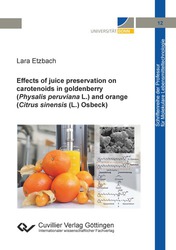| Fachbereiche | |
|---|---|
| Buchreihen (96) |
1378
|
| Nachhaltigkeit |
3
|
| Gesundheitswesen |
1
|
| Geisteswissenschaften |
2364
|
| Naturwissenschaften |
5406
|
| Mathematik | 229 |
| Informatik | 319 |
| Physik | 980 |
| Chemie | 1363 |
| Geowissenschaften | 131 |
| Humanmedizin | 243 |
| Zahn-, Mund- und Kieferheilkunde | 10 |
| Veterinärmedizin | 108 |
| Pharmazie | 147 |
| Biologie | 835 |
| Biochemie, Molekularbiologie, Gentechnologie | 121 |
| Biophysik | 25 |
| Ernährungs- und Haushaltswissenschaften | 45 |
| Land- und Agrarwissenschaften | 1004 |
| Forstwissenschaften | 201 |
| Gartenbauwissenschaft | 20 |
| Umweltforschung, Ökologie und Landespflege | 148 |
| Ingenieurwissenschaften |
1793
|
| Allgemein |
98
|
|
Leitlinien Unfallchirurgie
5. Auflage bestellen |
|
Erweiterte Suche
Effects of juice preservation on carotenoids in goldenberry (Physalis peruviana L.) and orange (Citrus sinensis (L.) Osbeck) (Band 12)
Lara Etzbach (Autor)Vorschau
Leseprobe, PDF (450 KB)
Inhaltsverzeichnis, PDF (120 KB)
Fruits are an important part of a balanced diet because of their high content in vitamins, minerals, dietary fiber, and bioactive compounds. Since the shelf life of fruits is limited due to microbiological, biochemical, and enzymatic reactions, processing and preservation are necessary to ensure food safety and year round availability.
The present thesis aimed to investigate the effects of commonly used processing methods for fruit juice and puree production such as thermal pasteurization, alternative pasteurization (HPP, PEF), ultrasonication, and spray drying on the stability of carotenoids in goldenberry (Physalis peruviana L.) and orange (Citrus sinensis (L.) Osbeck). This thesis reveals the potential of ultrasonication as a homogenization technology that could be applied in the fruit juice industry in combination with pasteurization for the improved production of fruit juices and purees rich in potentially bioavailable carotenoids. Moreover, in comparison to commonly used carrier agents for spray drying, cellobiose showed a high potential for the application as innovative carrier material to obtain fruit juice powders with good physicochemical properties while preserving valuable constituents such as carotenoids.
| ISBN-13 (Printausgabe) | 9783736975606 |
| ISBN-13 (E-Book) | 9783736965607 |
| Buchendformat | A5 |
| Sprache | Englisch |
| Seitenanzahl | 168 |
| Umschlagkaschierung | matt |
| Auflage | 1. |
| Buchreihe | Schriftenreihe der Professur für Molekulare Lebensmitteltechnologie |
| Band | 12 |
| Erscheinungsort | Göttingen |
| Promotionsort | Bonn |
| Erscheinungsdatum | 10.01.2022 |
| Allgemeine Einordnung | Dissertation |
| Fachbereiche |
Chemie
Lebensmittelchemie Ernährungs- und Haushaltswissenschaften |
| Schlagwörter | Orangensaft, Physalis peruviana, Citrus sinensis, Orange, Physalis, Carotinoide, Physalissaft, Physalispüree, Biozugänglichkeit, Sprühtrocknung, Cellobiose, Trägermaterial, Pasteurisation, Ultraschall, Hochdruckpasteurisation, gepulste elektrische Felder, PEF, HPP, Homogenisierung, Carotinoidabbau, Haltbarmachung, Früchte, Saft, Maltodextrin, Peroxidase, Saftqualität, Bioverfügbarkeit, Carotinoidfettsäureester, Saftverarbeitung, Safthaltbarmachung, Enzyminaktivierung, Verkapselungseffizienz, Pulvereigenschaften, Fruchtsaftindustrie, Trocknung, Carotinoidprofil, Carotinoidgehalt, Heißabfüllung, Xanthophylle, Carotine, Mizellierungseffizienz, Lagerstabiliät, Reststoffverwertung, orange juice, orange, goldenberry, carotenoids, physalis juice, physalis puree, bioaccessibility, spray drying, cellobiose, carrier agent, coating material, pasteurization, ultrasound technology, ultrasonication, high pressure processing, pulsed electric fields, homogenization, carotenoid degradation, preservation, fruits, juice, maltodextrin, peroxidase, juice quality, bioavailability, carotenoid fatty acid esters, juice production, juice preservation, enzyme inactivation, encapsulation efficiency, powder properties, fruit juice industry, drying, carotenoid profile, carotenoid content, hot filling, xanthophylls, carotenes, micellarization efficiency, storage stability, by-product utilization, Ernährung, human nutrition |
| URL zu externer Homepage | https://www.ilt.uni-bonn.de/publikationen |








